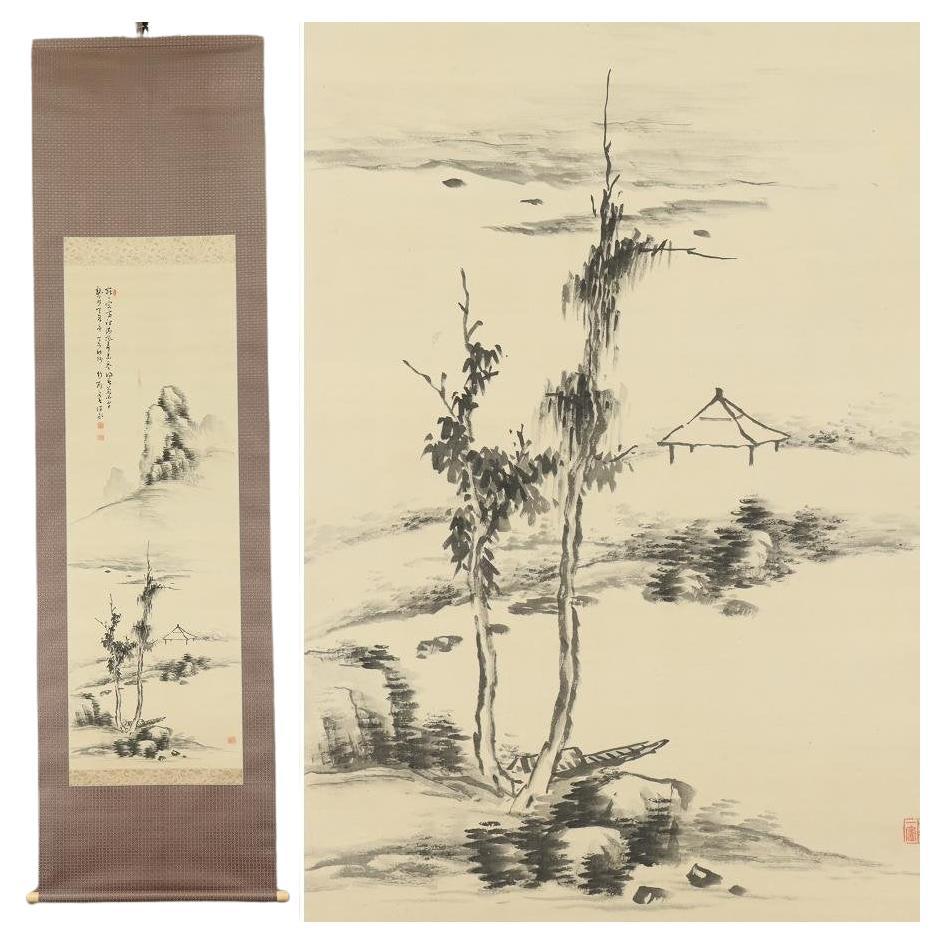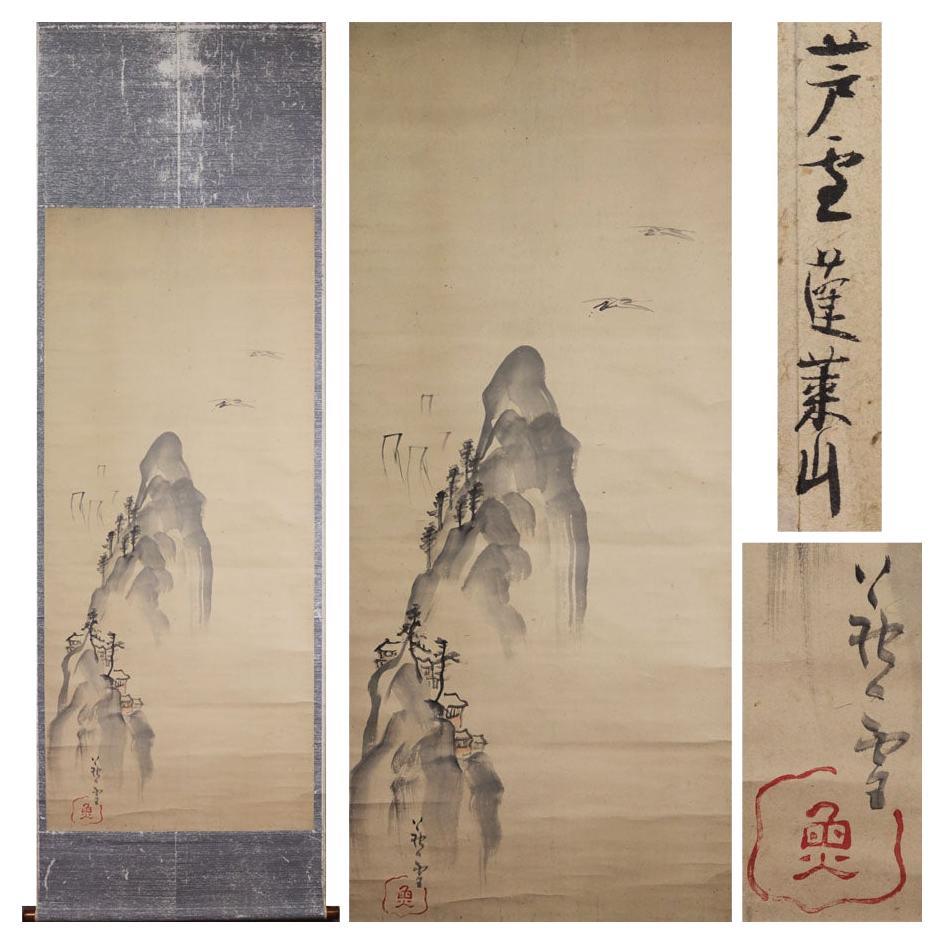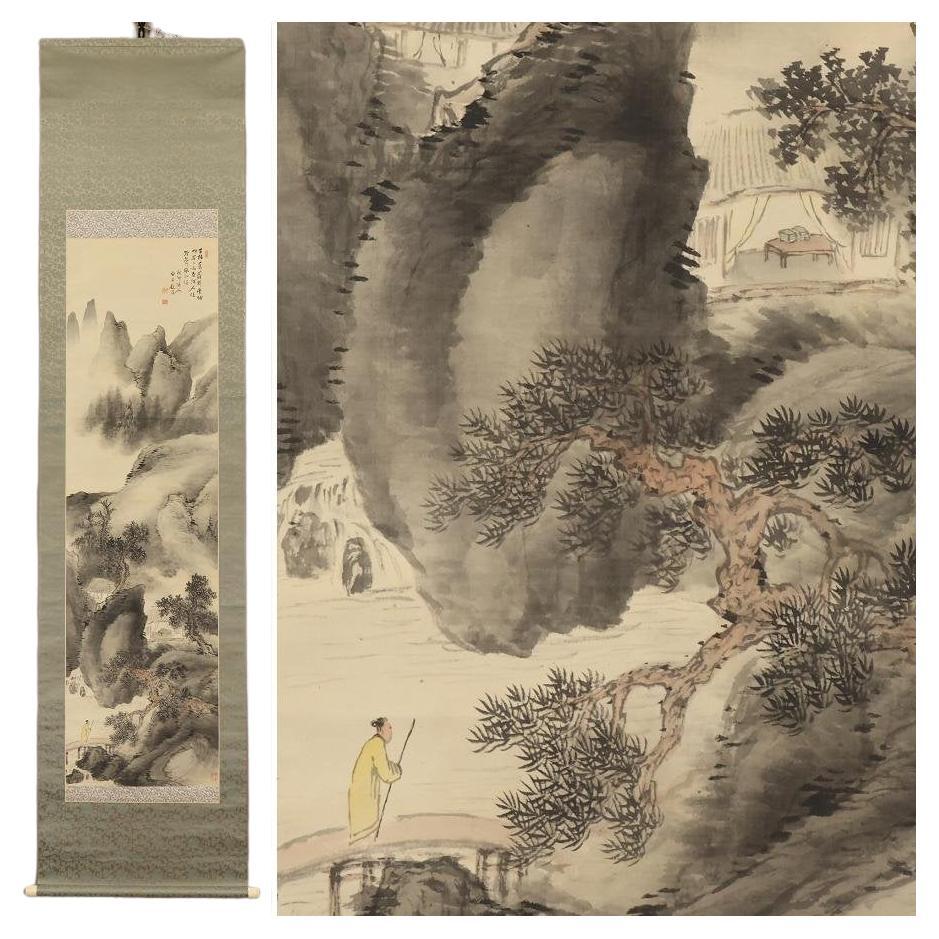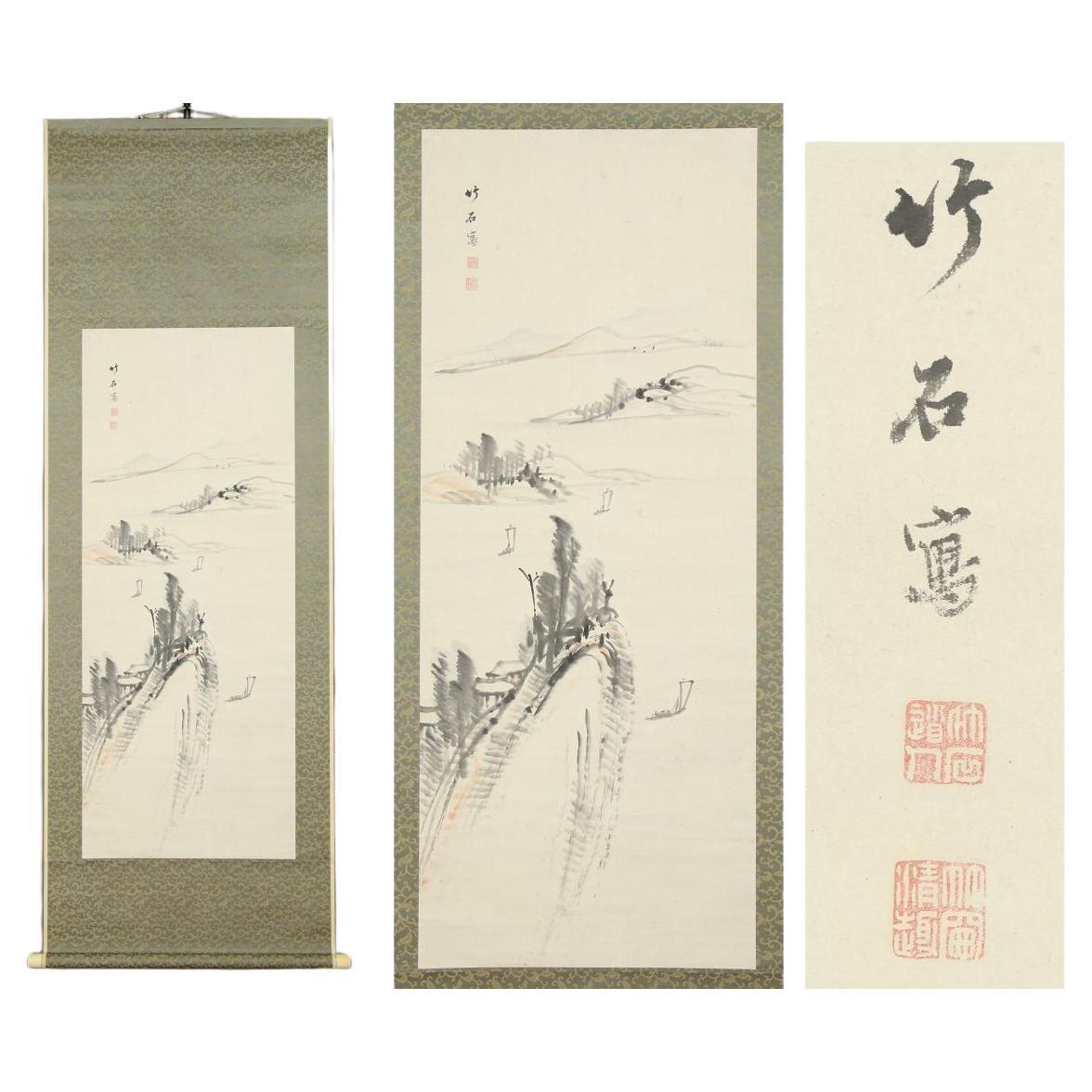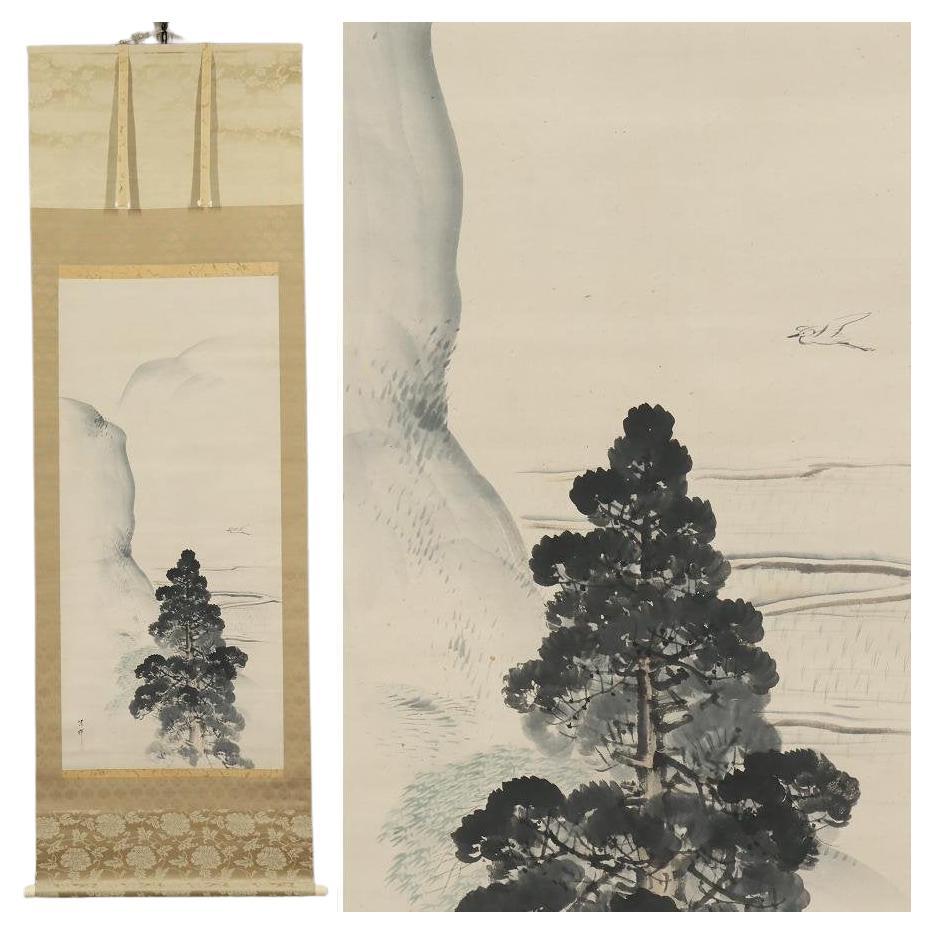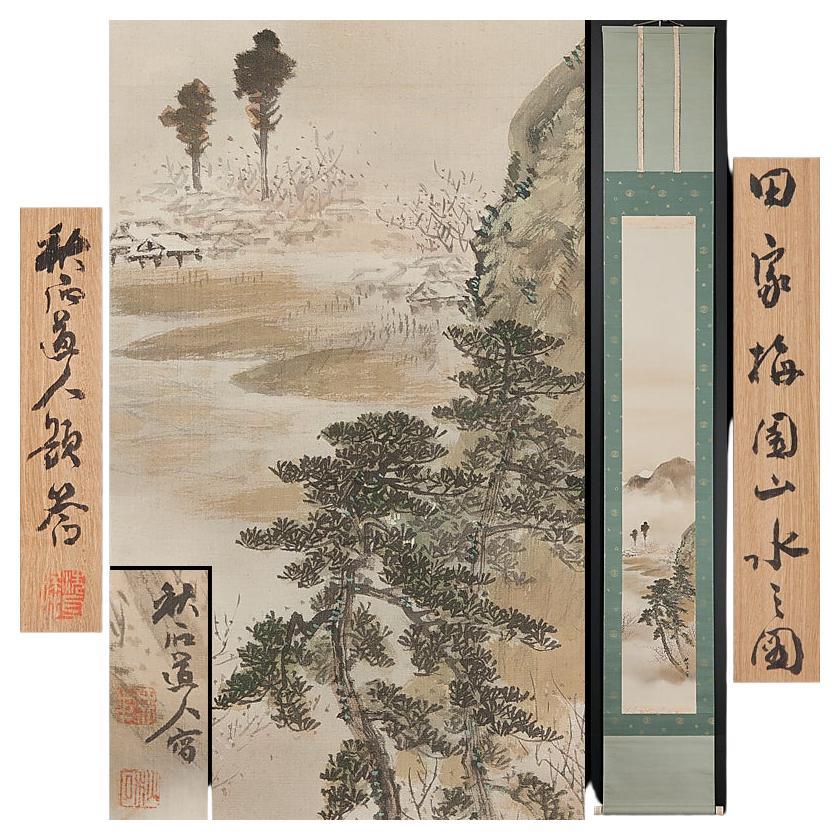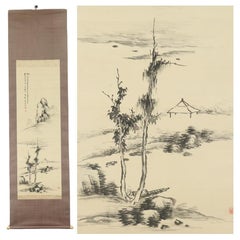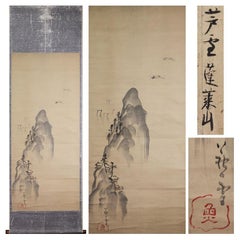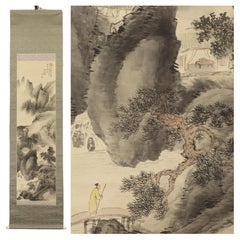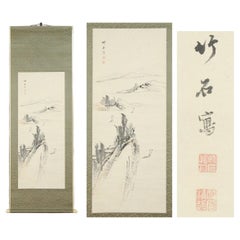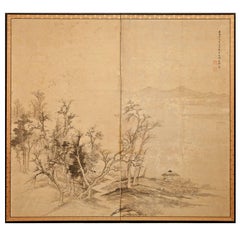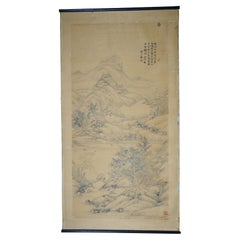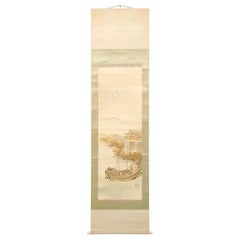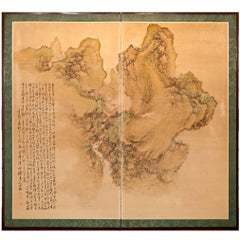Items Similar to Japanese Nihonga Painting 19th c Edo Scroll by Tonomura Chokunyu River landscape
Want more images or videos?
Request additional images or videos from the seller
1 of 12
Japanese Nihonga Painting 19th c Edo Scroll by Tonomura Chokunyu River landscape
$1,700.96
$2,126.2020% Off
£1,293.02
£1,616.2720% Off
€1,438.40
€1,79820% Off
CA$2,390.45
CA$2,988.0620% Off
A$2,599.27
A$3,249.0920% Off
CHF 1,369.56
CHF 1,711.9520% Off
MX$31,573.59
MX$39,466.9920% Off
NOK 17,218.16
NOK 21,522.6920% Off
SEK 16,140.63
SEK 20,175.7920% Off
DKK 11,009.82
DKK 13,762.2720% Off
About the Item
[Authentic work] ◆Tanomura Chokunyu ◆Ink painting landscape ◆Japanese painting ◆Handpainted ◆ Paper ◆ Hanging scroll ◆
Chokunyu Tanomura
1814 (Bunka 11) - 1907 (Meiji 40)
[Art yearbook appraised value 8 million yen]
"A child prodigy in painting, Tanomura Chokunyu originally modeled himself after the style of the famous Tanomura Chikuden (1777-1835), who had adopted him at the age of eight. After Chikuden's death, Chokunyu took up an intense study of imported Chinese paintings." Paul Berry in: Literati Modern, p.136.) - The certificate box was inscribed by Tajika Chikuson (1864-1922), one of Chokunyu's key disciples.
Around 1840, he studied Confucianism under Kotake Shinozaki in Osaka, deepened his friendships with Heihachiro Oshio and Tessai Tomioka through sencha, and began to be recognized as a painter.
Furthermore, in 1862, he founded and hosted the Seiwan Tea Ceremony (a sencha tea ceremony), which achieved great fame.
In 1868, he moved to Kyoto and participated in the establishment of the Kyoto Prefectural Painting School (opened in 1880), serving as its principal and making efforts to foster the next generation.Furthermore, in 1996, he established the Japan Nanga Association with Tessai and others, and established the Japan Nanga Association, which was established in modern Japan. He made a great contribution to painting and the southern painting world.
The subject matter of his paintings is wide-ranging, including landscapes, people, birds, beasts, animals, and flowers, and among these, his masterpieces remain in the southern style of landscapes, which express precise depictions and a magnificent force of vitality, and many of his works include compliments with Chinese poems.
He passed away on January 21, 1908 at the age of 93.
This work is drawn by hand and on paper.
The box is a combined box.
The paper has small stains, wrinkles, curling wrinkles, cuts, insect licks, and folds.
There are some small stains, wrinkles, and wrinkles on the cover, but it is generally in good condition.
This is a guaranteed genuine product, so please bid accordingly.
Size:
Approximately [height 199cm x width 53cm/(main paper) 142cm x 39cm]
- Dimensions:Height: 78.35 in (199 cm)Width: 20.87 in (53 cm)Depth: 0.04 in (1 mm)
- Style:Edo (Of the Period)
- Materials and Techniques:
- Period:
- Date of Manufacture:ca 1850
- Condition:Wear consistent with age and use.
- Seller Location:Amsterdam, NL
- Reference Number:Seller: 901stDibs: LU4863237083632
About the Seller
5.0
Vetted Professional Seller
Every seller passes strict standards for authenticity and reliability
Established in 2015
1stDibs seller since 2019
276 sales on 1stDibs
Typical response time: 2 hours
- ShippingRetrieving quote...Shipping from: Amsterdam, Netherlands
- Return Policy
Authenticity Guarantee
In the unlikely event there’s an issue with an item’s authenticity, contact us within 1 year for a full refund. DetailsMoney-Back Guarantee
If your item is not as described, is damaged in transit, or does not arrive, contact us within 7 days for a full refund. Details24-Hour Cancellation
You have a 24-hour grace period in which to reconsider your purchase, with no questions asked.Vetted Professional Sellers
Our world-class sellers must adhere to strict standards for service and quality, maintaining the integrity of our listings.Price-Match Guarantee
If you find that a seller listed the same item for a lower price elsewhere, we’ll match it.Trusted Global Delivery
Our best-in-class carrier network provides specialized shipping options worldwide, including custom delivery.More From This Seller
View AllJapanese Nihonga Painting 19th Meiji Scroll Tajika Chikuson Landscape Nanga
Located in Amsterdam, Noord Holland
[Authentic Artwork] ◆ Chikuson Tajika ◆ Autumn Landscape ◆ Master: Naoiri Tanomura ◆ Oita Prefecture ◆ Hand-Painted ◆ Silk Mounted ◆ Hanging Scroll ◆
Delve into the artistry of Chik...
Category
Antique 19th Century Edo Paintings
Materials
Silk
$1,133 Sale Price
20% Off
Antique Japanese 18th c Edo Scroll Rosetsu Nagasawa Nihonga Landscape Painting
Located in Amsterdam, Noord Holland
The following is a work of art depicting the ``Horai Landscape,'' a land of peach, created by the master artist
[Rosetsu Nagasawa]
A painter from the late Edo period.
There are conf...
Category
Antique 18th Century Edo Paintings
Materials
Silk
$1,511 Sale Price
20% Off
Japanese Painting Taisho / Showa Period Scroll by Shuson Kono Nanga Landscape
Located in Amsterdam, Noord Holland
Authentic work ◆ Shuson Kono ◆ Illustrated landscape of the literati ◆ Shared box ◆ Landscape ◆ Ehime Prefecture ◆ Handpainted ◆ Silk ◆ Hanging scrol...
Category
Vintage 1930s Taisho Paintings
Materials
Silk
$2,173 Sale Price
20% Off
Japanese Painting 18c Edo Scroll Chikuseki Nagamachi Nihonga Landscape Painting
Located in Amsterdam, Noord Holland
[Authentic Artwork] ◆ Nagamachi Chikuseki ◆ Landscape ◆ Edo Period ◆ Mitsuishi Origin ◆ Kagawa Prefecture ◆ Handwritten ◆ Paperback ◆ Hanging Scroll ◆ k891 ◆ Nagamachi Chikuseki
Explore the artistry of Chikuseki Nagamachi...
Category
Antique 18th Century Edo Paintings
Materials
Silk
$1,795 Sale Price
20% Off
Japanese Nihonga Painting 19th c Edo Scroll by Seiki Yokoyama Landscape Shijo
Located in Amsterdam, Noord Holland
[Authentic work] ◆ Seiki Yokoyama ◆ Landscape ◆ Rural landscape ◆ Japanese painting ◆ Shijo school ◆ Hand-painted ◆ Paperback ◆ Hanging scroll ◆
Seiki Yokoyama
[Art yearbook appra...
Category
Antique 19th Century Edo Paintings
Materials
Silk
$1,227 Sale Price
20% Off
Japanese Nihonga Painting 1900 Meiji/Taisho Scroll Shûseki, Okutani Landscape
Located in Amsterdam, Noord Holland
Susheki Okutani "Takaya Plum Garden Landscape"
Silk, Colored, Authentic, Hanging Scroll, , Double Box
size Axis: Height 206.5cm Width 29.3cm
Drawing…Height 126.7cm Width 19.5cm *There may be slight differences in dimensions. Thank you for your understanding.
situation It is in good condition, but please note that there are some light stains.
Please check the image for details.
Thank you for your support.
Biography Akishi Okutani
Japanese painter. Born in Osaka. His name is Tsunejiro. He studied under Kansai Mori. From an early age, he exhibited his works at the Japan Painting Association and the Young People's Painting Association, which was led by Gaho Hashimoto and Gyokusho Kawabata, and won numerous awards. He also opened a private school...
Category
20th Century Taisho Paintings
Materials
Silk
$1,700 Sale Price
20% Off
You May Also Like
Japanese Two-Panel Screen: Ink Landscape on Silk
By Shunyu
Located in Hudson, NY
Japanese Two Panel Screen: Ink Landscape on Silk, Meiji period (1868 - 1912) painting of a man riding a mule on a pathway through the Kurotani mountains with a thatched roof shelter ...
Category
Antique 19th Century Japanese Meiji Paintings and Screens
Materials
Silk, Wood
Chinese Sun Yunqiao 孫雲樵 Autumn Mountain Landscape Silk Scroll Painting 59"
Located in Dayton, OH
Mid to early century Chinese wall hanging scroll, painted with a pair of figures riding donkeys, crossing a bridge against a landscape of mountains and gnarled pines; by artist Sun Y...
Category
20th Century Chinese Chinoiserie Paintings and Screens
Materials
Wood, Paint, Paper
$1,000 Sale Price
20% Off
Japanese Meiji Riverside Scroll Painting, c. 1900
Located in Chicago, IL
Although western painting was initially embraced during Japan’s Meiji period (1868-1912), artists brought on a revival of traditional painting styles as they sought to create a modern Japanese style with roots in the past. This exquisite hanging scroll demonstrates the preference for soft layering of gray tones with judicious use of color. The landscape is rendered in soft ink washes that subtly distinguish between water, mountain, and sky. The scroll painting...
Category
Early 20th Century Japanese Meiji Paintings and Screens
Materials
Paper
Japanese Two Panel Screen: Mountain Landscape with Calligraphy
Located in Hudson, NY
Japanese Two Panel Screen: Mountain Landscape with Calligraphy. Late Edo (c. 1850) painting of a dramatic mountainside carved by a waterfall with a crane flying in the foreground an...
Category
Antique Mid-19th Century Japanese Edo Paintings and Screens
Materials
Silk, Wood, Paper
Japanese Painting of Mountain and village, Hanging Scroll
Located in Greenwich, CT
Japanese scroll painting depicted village in the mountain
Ink and paper. Artist signed
Overall size: 43" height. 21" width
Image size: 10.8" height. 16" width
I am planning to re...
Category
Vintage 1940s Japanese Paintings and Screens
Materials
Paper
$600 Sale Price
29% Off
Japanese Two Panel Screen Suiboku Landscape in Sesshu Style
Located in Hudson, NY
Suiboku is a style of ink painting that is reminicent of the way calligraphers paint. Masterfully painted Muromachi Period (1336-1573) painting, unique in style and strength for the period with very bold lines. Sesshu Toyo...
Category
Antique 16th Century Japanese Paintings and Screens
Materials
Silk, Paper
More Ways To Browse
Japanese Hanging Scroll
19th Silk Painting Birds Chinese
Velvet Painting Horse
Villard Painting
Vincent Garrison
Vintage Billiard Signs
Vintage Hunting Dog Paintings
W Anderson Oil Painting
W Carl Burger
Wally Hatny
Walter Pach
Waxman Artist
Wiki Painting
Wilhelm Blanke
William H Clapp
William Hugh Ferguson
William Kozar
Winifred Godfrey
